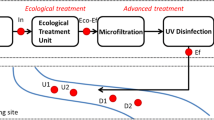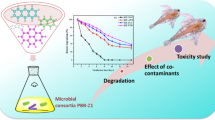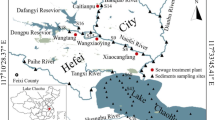Abstract
The first Italian annual monitoring study was carried out in Northern Italy to analyse the fate and removal of polycyclic musk fragrances (PMFs) in a wastewater treatment plant (WWTP) with conventional activated sludge (CAS) system. Water was sampled in four different stations along wastewater treatments to better understand the behaviour of PMFs along different steps of the plant. Galaxolide (HHCB) and galaxolidone (HHCB-lactone) were found in concentrations at μg L−1 level, 1 order of magnitude greater than tonalide (AHTN), whilst phantolide (AHDI) was never detected and celestolide (ADBI) was measured only at trace levels. Considering water concentrations, HHCB and AHTN evidenced a slight reduction, 20% and 50%, respectively, during wastewater treatments, thus resulting in a modest removal efficiency, mainly due to adsorption processes during the biological treatment. This was also confirmed by the high PMF concentrations measured in activated sludges which remained stable throughout the year. On the contrary, HHCB-lactone registered an increase up to 70% during wastewater treatments caused by the biotransformation of the parental compound HHCB during the biological treatment, as shown by the different HHCB-lactone/HHCB ratio measured before and after this step. No significant differences were recorded between seasons in terms of PMF input onto WWTP, in accordance with the common use of these chemicals in civil houses. Overall, this study suggests that current technologies employed in conventional WWTP are not enough efficient in removing these organic micropollutants from wastewaters and, therefore, WWTP effluents represent possible point sources of pollution for aquatic ecosystems. Additional treatments are necessary to enhance the removal of PMFs in order to increase the quality of the WWTP effluents.




Similar content being viewed by others
References
Arrubla JP, Cubillos JA, Ramírez CA, Arredondo JA, Arias CA, Paredes D (2016) Pharmaceutical and personal care products in domestic wastewater and their removal in anaerobic treatment systems: septic tank–up flow anaerobic filter. Ing e Investig 36:70–78. https://doi.org/10.15446/ing.investig.v36n1.53076
Ávila C, García J (2015) Pharmaceuticals and personal care products (PPCPs) in the environment and their removal from wastewater through constructed wetlands. Compr Anal Chem 67:195–244. https://doi.org/10.1016/B978-0-444-63299-9.00006-5
Besha AT, Gebreyohannes AY, Tufa RA, Bekele DN, Curcio E, Giorno L (2017) Removal of emerging micropollutants by activated sludge process and membrane bioreactors and the effects of micropollutants on membrane fouling: a review. J Environ Chem Eng 5:2395–2414. https://doi.org/10.1016/j.jece.2017.04.027
Bester K (2004) Retention characteristics and balance assessment for two polycyclic musk fragrances (HHCB and AHTN) in a typical German sewage treatment plant. Chemosphere 57:863–870. https://doi.org/10.1016/j.chemosphere.2004.08.032
Blahova J, Divisova L, Plhalova L, Enevova V, Hostovsky M, Doubkova V, Marsalek P, Fictum P, Svobodova Z (2018) Multibiomarker responses of juvenile stages of zebrafish (Danio rerio) to subchronic exposure to polycyclic musk tonalide. Arch Environ Contam Toxicol 74:568–576. https://doi.org/10.1007/s00244-017-0484-8
Chen F, Gao J, Zhou Q (2012) Toxicity assessment of simulated urban runoff containing polycyclic musks and cadmium in Carassius auratus using oxidative stress biomarkers. Environ Pollut 162:91–97. https://doi.org/10.1016/j.envpol.2011.10.016
Cirja M, Ivashechkin P, Schäffer A, Corvini PFX (2008) Factors affecting the removal of organic micropollutants from wastewater in conventional treatment plants (CTP) and membrane bioreactors (MBR). Rev Environ Sci Bio/Technol 7:61–78. https://doi.org/10.1007/s11157-007-9121-8
Clara M, Gans O, Windhofer G, Krenn U, Hartl W, Braun K, Scharf S, Scheffknecht C (2011) Occurrence of polycyclic musks in wastewater and receiving water bodies and fate during wastewater treatment. Chemosphere 82:1116–1123. https://doi.org/10.1016/j.chemosphere.2010.11.041
DiFrancesco AM, Chiu PC, Standley LJ, Allen HE, Salvito DT (2004) Dissipation of fragrance materials in sludge-amended soils. Environ. Sci Technol 38:194–201. https://doi.org/10.1021/es034618v
Dsikowitzky L, Schwarzbauer J, Littke R (2002) Distribution of polycyclic musks in water and particulate matter of the Lippe River (Germany). Org Geochem 33:1747–1758. https://doi.org/10.1016/S0146-6380(02)00115-8
ECHA – European Chemicals Agency (2009) Recommendation of the European Chemical Agency (ECHA) of 1 June 2009 for the inclusion of substances in Annex XIV (the list of substances subject to authorisation) of Regulation (EC) No 1907/2006 https://iuclid6.echa.europa.eu/documents/10162/13640/annex_xiv_subst_inclusion_en.pdf/13e903f2-5aba-41b7-b513-59c4388083af. Accessed 01 March 2021
EU-RAR (2008) 1-(5,6,7,8-tetrahydro-3,5,5,6,8,8-hexamethyl-2-napthyl)ethan-1-one (Ahtn). Rep AHTN 259. https://www.echa.europa.eu/documents/10162/26e223a9-eda9-4e79-8c4d-650d2a3c1124. Accessed 01 March 2021
European Commission (2003) European Union Risk Assessment Report, Naphthalene. EUR 20763 EN, 1st Prior List https://echa.europa.eu/documents/10162/4c955673-9744-4d1c-a812-2bf97863906a. Accessed 01 March 2021
Fernandez-Fontaina E, Pinho I, Carballa M, Omil F, Lema JM (2013) Biodegradation kinetic constants and sorption coefficients of micropollutants in membrane bioreactors. Biodegradation 24:165–177. https://doi.org/10.1007/s10532-012-9568-3
Heberer T (2003) Occurrence, fate, and assessment of polycyclic musk residues in the aquatic environment of urban areas—a review. Acta Hydrochim Hydrobiol 30:227–243. https://doi.org/10.1002/aheh.200390005
HERA (2004) HERA Environmental Risk Assessment Polycyclic musks AHTN and HHCB 1–80. https://www.heraproject.com/files/28-E-36551E10-F8EF-E807-E4199B9BB0076A9F.pdf. Accessed 01 March 2021
Horii Y, Reiner JL, Loganathan BG, Senthil Kumar K, Sajwan K, Kannan K (2007) Occurrence and fate of polycyclic musks in wastewater treatment plants in Kentucky and Georgia, USA. Chemosphere 68:2011–2020. https://doi.org/10.1016/j.chemosphere.2007.04.054
Hu Z, Shi Y, Niu H, Cai Y, Jiang G, Wu Y (2010) Occurrence of synthetic musk fragrances in human blood from 11 cities in China. Environ. Toxicol Chem 29:1877–1882. https://doi.org/10.1002/etc.258
Hu Z, Shi Y, Cai Y (2011) Concentrations, distribution, and bioaccumulation of synthetic musks in the Haihe River of China. Chemosphere 84:1630–1635. https://doi.org/10.1016/j.chemosphere.2011.05.013
Kupper T, Berset JD, Etter-Holzer R, Furrer R, Tarradellas J (2004) Concentrations and specific loads of polycyclic musks in sewage sludge originating from a monitoring network in Switzerland. Chemosphere 54:1111–1120. https://doi.org/10.1016/j.chemosphere.2003.09.023
Lange C, Kuch B, Metzger JW (2015) Occurrence and fate of synthetic musk fragrances in a small German river. J Hazard Mater 282:34–40. https://doi.org/10.1016/j.jhazmat.2014.06.027
Lou Y, Wang J, Wang L, Shi L, Yu Y, Zhang M (2016) Determination of synthetic musks in sediments of Yellow River delta wetland. China Bull Environ Contam Toxicol 97:78–83. https://doi.org/10.1007/s00128-016-1814-7
Lung SCC, Liu CH (2011) High-sensitivity analysis of six synthetic Musks by ultra-performance liquid chromatography–atmospheric pressure photoionization–tandem mass spectrometry. Anal Chem 83:4955–4961. https://doi.org/10.1021/ac2006872
Luo Y, Guo W, Ngo HH, Nghiem LD, Hai FI, Zhang J, Liang S, Wang XC (2014) A review on the occurrence of micropollutants in the aquatic environment and their fate and removal during wastewater treatment. Sci Total Environ 473–474:619–641. https://doi.org/10.1016/j.scitotenv.2013.12.065
Mersch-Sundermann V, Schneider H, Freywald C, Jenter C, Parzefall W, Knasmüller S (2001) Musk ketone enhances benzo(a)pyrene induced mutagenicity in human derived Hep G2 cells. Mutat Res Genet Toxicol Environ Mutagen 495:89–96. https://doi.org/10.1016/S1383-5718(01)00202-9
O.S.P.A.R. Commission (2004) Hazardous substances series, musk xylene and other musks. London, UK. https://www.ospar.org/documents?v=6978. Accessed 01 March 2021
Parolini M, Magni S, Traversi I, Villa S, Finizio A, Binelli A (2015) Environmentally relevant concentrations of galaxolide (HHCB) and tonalide (AHTN) induced oxidative and genetic damage in Dreissena polymorpha. J Hazard Mater 285:1–10. https://doi.org/10.1016/j.jhazmat.2014.11.037
Posada-Ureta O, Olivares M, Navarro P, Vallejo A, Zuloaga O, Etxebarria N (2012) Membrane assisted solvent extraction coupled to large volume injection-gas chromatography-mass spectrometry for trace analysis of synthetic musks in environmental water samples. J Chromatogr A 1227:38–47. https://doi.org/10.1016/j.chroma.2011.12.104
Reiner JL, Berset JD, Kannan K (2007) Mass flow of polycyclic musks in two wastewater treatment plants. Arch Environ Contam Toxicol 52:451–457. https://doi.org/10.1007/s00244-006-0203-3
Sapozhnikova Y, Liebert D, Wirth E, Fulton M (2010) Polycyclic musk fragrances in sediments and shrimp tissues. Polycycl Aromat Compd 30:298–308. https://doi.org/10.1080/10406638.2010.525160
Shrivastava A, Gupta V (2011) Methods for the determination of limit of detection and limit of quantitation of the analytical methods. Chronicles Young Sci 2:21. https://doi.org/10.4103/2229-5186.79345
Tasselli S, Guzzella L (2020) Polycyclic musk fragrances (PMFs) in wastewater and activated sludge: analytical protocol and application to a real case study. Environ Sci Pollut Res 27:30977–30986. https://doi.org/10.1007/s11356-019-06767-7
Ternes TA, Herrmann N, Bonerz M, Knacker T, Siegrist H, Joss A (2004) A rapid method to measure the solid–water distribution coefficient (Kd) for pharmaceuticals and musk fragrances in sewage sludge. Water Res 38:4075–4084. https://doi.org/10.1016/j.watres.2004.07.015
Tumová J, Šauer P, Golovko O, Ucun OK, Grabic R, Máchová J, Kroupová HK (2019) Effect of polycyclic musk compounds on aquatic organisms: a critical literature review supplemented by own data. Sci Total Environ 651:2235–2246
Villa S, Assi L, Ippolito A, Bonfanti P, Finizio A (2012) First evidences of the occurrence of polycyclic synthetic musk fragrances in surface water systems in Italy: spatial and temporal trends in the Molgora River (Lombardia Region, Northern Italy). Sci Total Environ 416:137–141. https://doi.org/10.1016/j.scitotenv.2011.11.027
Weinberg I, Dreyer A, Ebinghaus R (2011) Landfills as sources of polyfluorinated compounds, polybrominated diphenyl ethers and musk fragrances to ambient air. Atmos Environ 45:935–941. https://doi.org/10.1016/j.atmosenv.2010.11.011
Yang JJ, Metcalfe CD (2006) Fate of synthetic musks in a domestic wastewater treatment plant and in an agricultural field amended with biosolids. Sci Total Environ 363:149–165. https://doi.org/10.1016/j.scitotenv.2005.06.022
Zhang X, Yao Y, Zeng X, Qian G, Guo Y, Wu M, Sheng G, Fu J (2008) Synthetic musks in the aquatic environment and personal care products in Shanghai, China. Chemosphere 72:1553–1558. https://doi.org/10.1016/j.chemosphere.2008.04.039
Zeng X, Sheng G, Xiong Y, Fu J (2005) Determination of polycyclic musks in sewage sludge from Guangdong, China using GC–EI-MS. Chemosphere 60:817–823. https://doi.org/10.1016/j.chemosphere.2005.04.026
Zhou Q, Deng S, Zhang Q, Fan Q, Huang J, Yu G (2010) Sorption of perfluorooctane sulfonate and perfluorooctanoate on activated sludge. Chemosphere 81:453–458. https://doi.org/10.1016/j.chemosphere.2010.08.009
Acknowledgements
We like to thank Società Italiana Acetilene E Derivati (SIAD), project partner, for its technical support during sampling activities and article drafting.
Availability of data and materials
All data generated or analysed during this study are included in this published article and its supplementary information files.
Funding
This work was financially supported by project PerFORMWATER 2030, ID 240750 (POR FESR 2014–2020 Asse I-Accordi per la Ricerca e l’Innovazione).
Author information
Authors and Affiliations
Contributions
ST performed the experiments, elaborated the corresponding data and wrote the manuscript with support from LG. EV performed the analysis and contributed to the interpretation of the results. LG supervised the project. All authors read and approved the final manuscript.
Corresponding author
Ethics declarations
Ethics approval and consent to participate
Not applicable.
Consent for publication
Not applicable.
Competing interests
The authors declare that they have no competing interests.
Additional information
Responsible Editor: Ta Yeong Wu
Publisher’s note
Springer Nature remains neutral with regard to jurisdictional claims in published maps and institutional affiliations.
Supplementary Information
ESM 1
(DOCX 102 kb)
Rights and permissions
About this article
Cite this article
Tasselli, S., Valenti, E. & Guzzella, L. Polycyclic musk fragrance (PMF) removal, adsorption and biodegradation in a conventional activated sludge wastewater treatment plant in Northern Italy. Environ Sci Pollut Res 28, 38054–38064 (2021). https://doi.org/10.1007/s11356-021-13433-4
Received:
Accepted:
Published:
Issue Date:
DOI: https://doi.org/10.1007/s11356-021-13433-4




